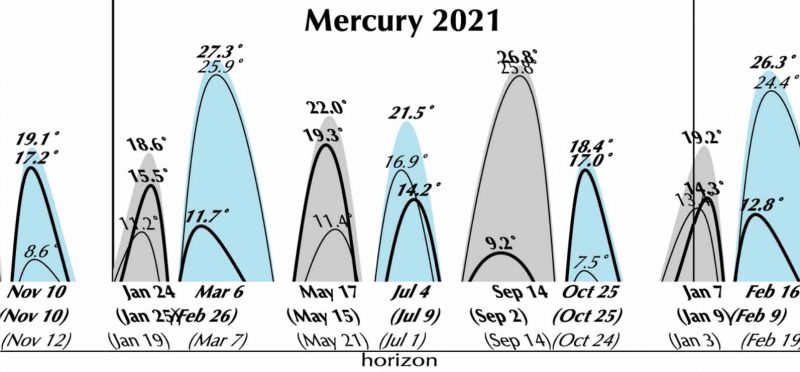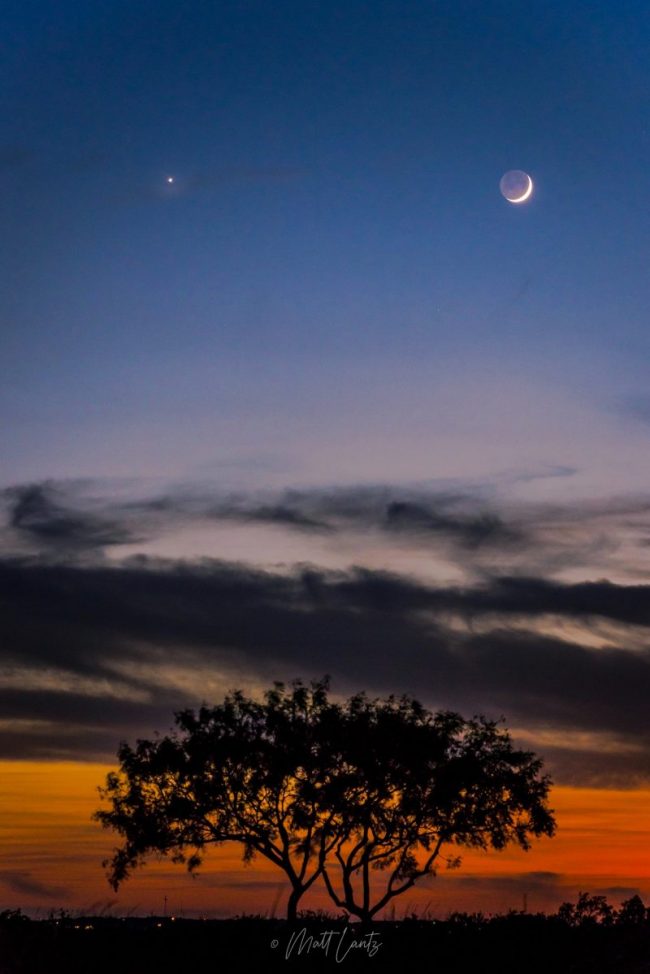
Moon and Venus, plus Antares
A crescent moon and Venus are low in the west after sunset on September 8 to 11, 2021. The moon is near our line of sight to the sun, setting soon after the sun on September 8. But then, day by day, the waxing crescent appears higher in the west and is easier to see. It’ll sweep past Venus and then move closer to red Antares, Heart of Scorpius the Scorpion. Venus will remain in the west after sunset for the rest of 2021. But, as the September equinox approaches, Antares is now shifting into the sunset glare.
New moon falls early in the day on September 7, 2021 (00:51 UTC). By the evening of September 8, the moon will be a good distance from the sun in your sky. But the evening angle of the ecliptic – or path of the sun and moon – will keep the waxing crescent low in the sky for us in the Northern Hemisphere. The Southern Hemisphere, where spring is coming, has a more glorious view. That’s because, from there, the ecliptic is more nearly perpendicular to the sunset horizon at this time of year.
Moon’s setting time in your sky
Here are a few places you can find out the moon’s setting time in your sky:
timeanddate.com (worldwide)
Old Farmer’s Almanac (U.S. and Canada)
Sunrise Sunset Calendars (be sure to click moon phase box)

Southern Hemisphere enjoys the advantage
Take a look at the sky chart immediately above for the Southern Hemisphere. The Southern Hemisphere is more likely to spot a younger moon than we will in the Northern Hemisphere. Moreover, southerly latitudes will enjoy a ringside seat to two other starlike objects: the planet Mercury and the star Spica. At mid-and-far northerly latitudes, Mercury and Spica will likely be too deeply buried in the sun’s afterglow to be visible.
Note the ecliptic – green line – on the sky chart a short hop above for 35 degrees south latitude. Contrast that chart with the one at top for 40 degrees north latitude. The ecliptic hits the horizon at a steep angle (nearly vertically) in the Southern Hemisphere, yet at a shallow angle at northerly latitudes.
Ecliptic, the pathway of the sun, moon and planets
The ecliptic depicts the Earth’s orbital plane projected onto the great dome of the sky. In another way of looking at it, the ecliptic traces out the sun’s yearly path in front of the constellations of the zodiac. Practiced sky watchers know to look for the moon and planets on or near the ecliptic.
In either the Northern or Southern Hemisphere, the angle of the ecliptic is shallowest for the year (closest to horizontal) at sunset on the autumn equinox. In stark contrast, the angle of the ecliptic at sunset is steepest for the year (closest to vertical) on the spring equinox. Keep in mind that the September equinox counts as the Northern Hemisphere’s autumn equinox, and the Southern Hemisphere’s spring equinox.
The elongation (or angular distance) of Venus, Mercury and Spica from the sun is the same in both hemispheres. Yet, their altitude – angular distance above the horizon – at sunset varies greatly. In fact, the variation is greatest during an equinox month, in September or March.
Mercury superb from Southern Hemisphere
Let’s take, for example, the planet Mercury. On September 8, Mercury is 26 degrees from the setting sun. Mercury will reach its greatest evening elongation of nearly 27 degrees on September 14. Fortunately for the Southern Hemisphere, the steep tilt of the ecliptic keeps Mercury out till after dark. At 35 degrees south latitude, Mercury now stays out for over 2 hours after sunset.
Unfortunately for the Northern Hemisphere, the narrow angle of the ecliptic submerges Mercury into the sun’s afterglow. At 35 degrees north latitude, Mercury struggles to stay out for as long as one hour after sundown.
Mercury’s setting time in your sky
Find out Mercury’s setting time in your sky via timeanddate.com (worldwide) or Old Farmer’s Almanac (U.S. and Canada).



Bottom line: From almost everywhere worldwide, expect a beautiful sight as the moon and Venus appear near each other in the west after sunset on September 8-11, 2021.











